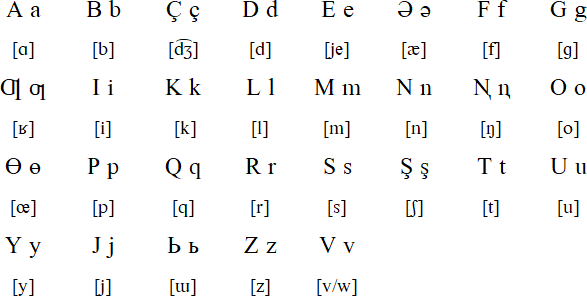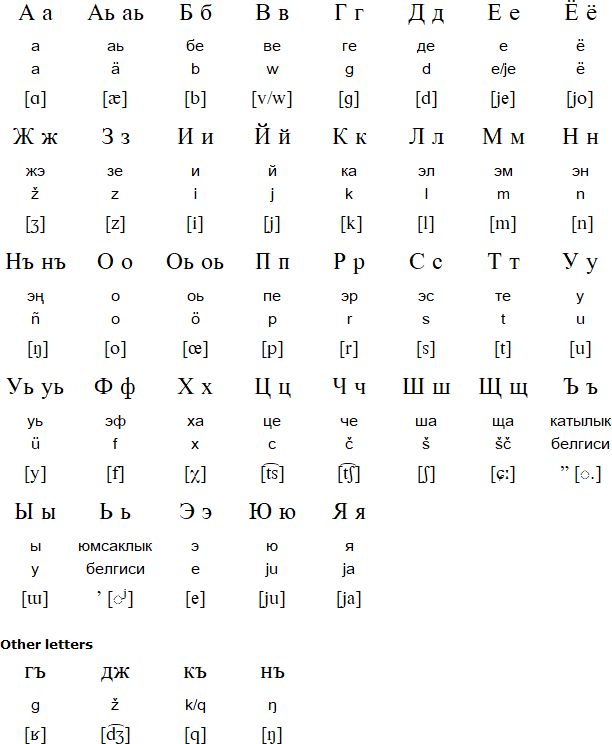Nogai is a Turkic language spoken by about 87,000 people in southwest of the Russian Federation, in particular in the Karachay-Cherkessia republic; in the Babayurt, Kizlyar, Nogay, and Tarumovka districts of the Dagestan republic; and in Shelkovskaya and Stavropol districts of the Chechnya republic. There also some speakers of Nogai in Central Anatolia in Turkey, mainly in Ceyhan, Ankara and Eskisehir provinces.
The Nogai people are descended from the Golden Horde, part of the Mongol Empire from the 1240s to 1502, and they are named after Nogai Khan, a grandson of Genghis Khan.
Nogai is also known as Karanogai, Kubanogai, Nogaitsy, Nogalar, Nogay, Noghai, Noghay, Noghaylar or Yurt Tatar. Dialects include Central Nogai or Nogai Proper, which is spoken in Stavropool; Karanogay or Qara-Nogai (Black/Northern Nogai), which is spoken in Dagestan and Chechnya, and Aqnogai (White/Western Nogai), which is spoken in Karachay-Cherkessia.
Nogai was first written with a version of the Arabic alphabet when the Nogai became Muslims. From 1928 to 1938 it was written with the Latin alphabet, and with the Cyrillic alphabet after that. In Turkey, Romania and a number of other countries Nogai is currently written with the Latin alphabet.
Nogai was taught in primary schools for the first five years until 1957. Since then there have been some lessons but in many schools they are optional. Two Nogai newspapers were published from 1973 in Karachay-Cherkessia and Dagestan.
This version of the Latin alphabet for Nogai was introduced in 1928 and was devised by Abdul-Khamid Shershenbievich Dzhanibekov, a Nogai academic. Various reforms were made to the alphabet in 1931, 1933 and 1935.

A proposal to adopt the Cyrillic alphabet was introduced in 1937 and published in 1938. It was revised in 1944 and 1960.

The alphabet is used to write Nogai in Turkey, Romania and a number of other countries.

Былай айтып, дува этинъиз,--деди оларга Иса: Аспандагы Атамыз, Сенинъ атынъ сыйлы болсын! Сенинъ Патшалыгынъ келсин, Сенинъ эркинъ, коьктегиндей, Ерде де этилинсин. Куьнлик оьтпегимизди бизге аьр куьнге берип тур. Аьр кимнинъ борышларын биз кеширгендей, Куьналарымызды кешир. Бизди азгырувга туьсирме, Яманлыктан бизди куткар.
Bılay aytıp, duva etiñiz,--dedi olarğa İsa: Aspandağı Atamız, Seniñ atıñ sıylı bolsın! Seniñ Patşalığıñ kelsin, Seniñ erkiñ köktegindey, Yerde de etilinsin. Künlik ötpegimizdi bizge är künge berip tur. Är kimniñ borışların biz keşirgendey, Künalarımızdı keşir. Bizdi azğıruvğa tüsirme, Yamanlıqtan bizdi qutqar.
He said to them, "When you pray, say: 'Father, hallowed be your name, your kingdom come, your will be done, on earth as it is in heaven. Give us each day our daily bread. Forgive us our sins, for we also forgive everyone who sins against us. And lead us not into temptation"
part of Lord's prayer (Luke 11:2-4)
Барлык кишилер азад ве айны хаклар ман тувганлар. Акыл ве видждан саиби бoлалар ве бирбирлерине акайлык руху ман давранмалары керекир.
Barlıq kişiler azad ve aynı haqlar man tuvğanlar. Aqıl ve vicdan saibi bolalar ve birbirlerine aqaylıq ruhu man davranmaları kerekir.
All human beings are born free and equal in dignity and rights. They are endowed with reason and conscience and should act towards one another in a spirit of brotherhood.
(Article 1 of the Universal Declaration of Human Rights)
Details and corrections provided by 이윤호 (Yun-ho Lee), Julijan Jovanović and TE
Information about Nogai | Phrases | Numbers | Tower of Babel
Information about the Nogai language and people
http://en.wikipedia.org/wiki/Nogai_language
https://en.wikipedia.org/wiki/Nogais
https://en.wikipedia.org/wiki/Nogai_alphabets
https://ru.wikipedia.org/wiki/Ногайская_письменность
https://ru.wikipedia.org/wiki/Новый_тюркский_алфавит
http://www.eki.ee/books/redbook/nogays.shtml
https://www.ethnologue.com/language/nog
Nogai grammar
http://noghai.livejournal.com/
Altay, Äynu, Azerbaijani, Bashkir, Chagatai, Chelkan, Chulym, Chuvash, Crimean Tatar, Dolgan, Fuyu Kyrgyz, Gagauz, Ili Turki, Karachay-Balkar, Karaim, Karakalpak, Karamanli Turkish, Kazakh, Khakas, Khalaj, Khorasani Turkic, Krymchak, Kumandy, Kumyk, Kyrgyz, Lop, Nogai, Old Turkic, Qashqai, Romanian Tatar, Salar, Shor, Siberian Tatar, Soyot, Tatar, Teleut, Tofa, Turkish, Turkmen, Tuvan, Urum, Uyghur, Uzbek, Western Yugur, Yakut (Sakha)
Abaza, Abkhaz, Adyghe, Aghul, Akhvakh, Akkala Sámi, Aleut, Altay, Alyutor, Andi, Archi, Assyrian / Neo-Assyrian, Avar, Azeri, Bagvalal, Balkar, Bashkir, Belarusian, Bezhta, Bosnian, Botlikh, Budukh, Bulgarian, Buryat, Chamalal, Chechen, Chelkan, Chukchi, Chulym, Chuvash, Crimean Tatar, Dargwa, Daur, Dolgan, Dungan, Enets, Erzya, Even, Evenki, Gagauz, Godoberi, Hinukh, Hunzib, Ingush, Interslavic, Itelmen, Juhuri, Kabardian, Kaitag, Kalderash Romani, Kalmyk, Karaim, Karakalpak, Karata, Karelian, Kazakh, Ket, Khakas, Khanty, Khinalug, Khorasani Turkic, Khwarshi, Kildin Sámi, Kili, Komi, Koryak, Krymchak, Kryts, Kubachi, Kumandy, Kumyk, Kurdish, Kyrgyz, Lak, Lezgi, Lingua Franca Nova, Lithuanian, Ludic, Macedonian, Mansi, Mari, Moksha, Moldovan, Mongolian, Montenegrin, Nanai, Negidal, Nenets, Nganasan, Nivkh, Nogai, Old Church Slavonic, Oroch, Orok, Ossetian, Pontic Greek, Romanian, Rushani, Russian, Rusyn, Rutul, Selkup, Serbian, Shor, Shughni, Siberian Tatar, Sirenik, Slovio, Soyot, Tabassaran, Tajik, Talysh, Tat, Tatar, Teleut, Ter Sámi, Tindi, Tofa, Tsakhur, Tsez, Turkmen, Tuvan, Ubykh, Udege, Udi, Udmurt, Ukrainian, Ulch, Urum, Uyghur, Uzbek, Veps, Votic, Wakhi, West Polesian, Xibe, Yaghnobi, Yakut, Yazghulami, Yukaghir (Northern / Tundra), Yukaghir (Southern / Kolyma), Yupik (Central Siberian)
Languages written with the Latin alphabet
Page last modified: 13.09.22
[top]
You can support this site by Buying Me A Coffee, and if you like what you see on this page, you can use the buttons below to share it with people you know.

If you like this site and find it useful, you can support it by making a donation via PayPal or Patreon, or by contributing in other ways. Omniglot is how I make my living.
Note: all links on this site to Amazon.com, Amazon.co.uk
and Amazon.fr
are affiliate links. This means I earn a commission if you click on any of them and buy something. So by clicking on these links you can help to support this site.
[top]